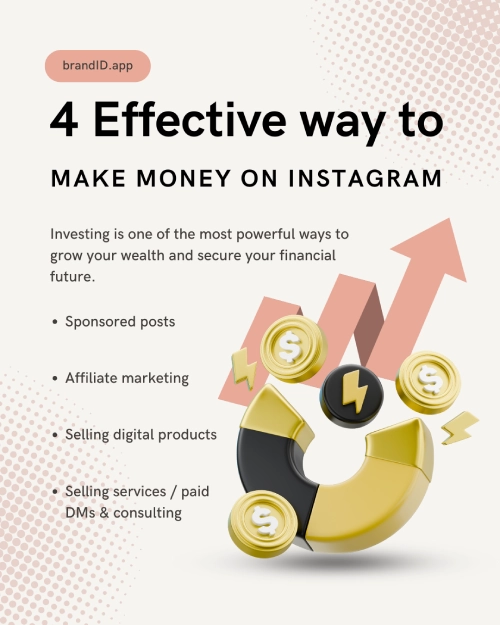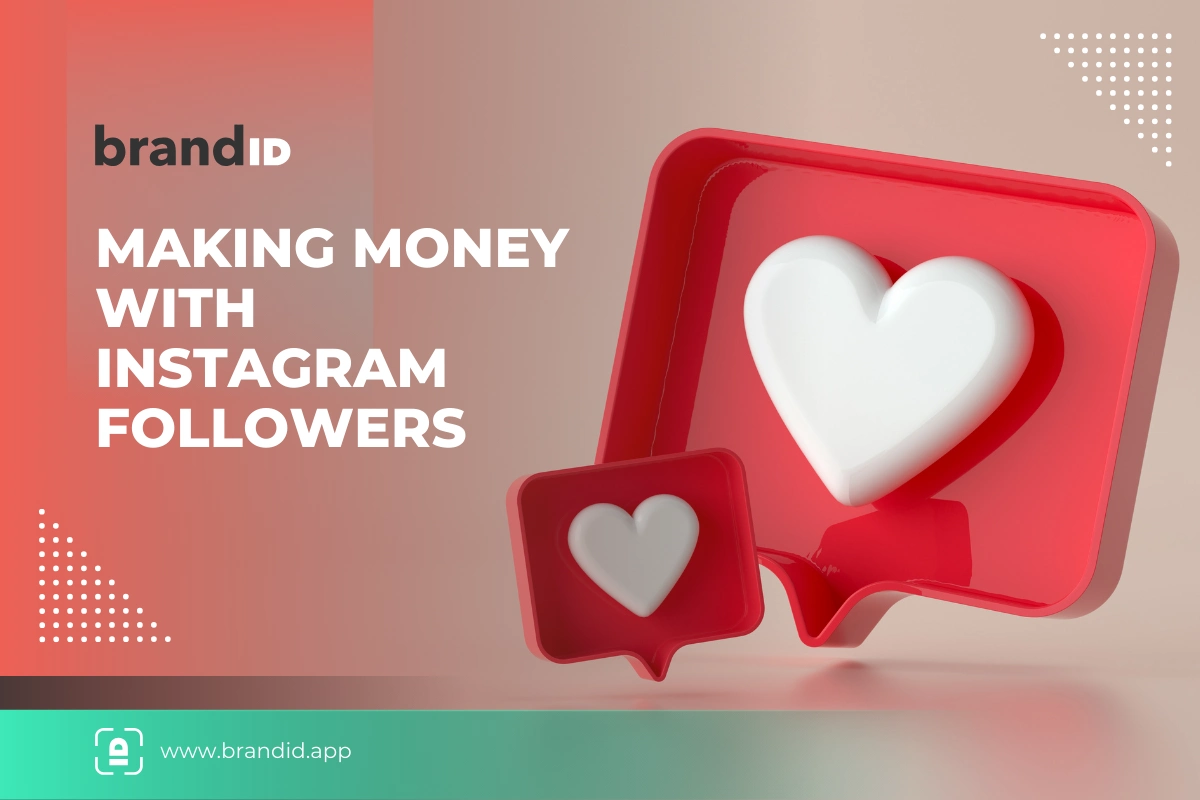In contrast to the widespread belief, you don’t necessarily need 100K followers to start making money on Instagram. This misconception often keeps creators posting for free without a proper strategy, assuming they have to hit some huge milestone before monetization is possible.
The truth is, if you’ve ever wondered How Many Followers on Instagram to Get Paid, the answer might surprise you. You can start earning with as few as 1,000 followers, as long as you focus on the right strategy, engage your audience effectively, and use digital content monetization tools like brandID to turn even a small audience into a consistent income stream.
By the end of this blog, you’ll understand exactly how many followers you need to start earning real money on Instagram, the key follower thresholds that matter, and smart monetization methods you can use regardless of your follower count.
How Do People Make Money on Instagram?

There are actually dozens of different ways to make money on Instagram. Influencers often turn their audience’s attention into real income by promoting other brands’ products or services. However, you don’t need to be a big-name influencer to start earning — there are several practical methods anyone can use. Below are some of the most common and effective ways to monetize your Instagram presence:
- Sponsored posts
Depending on your niche and engagement rate, brands may pay you to create content featuring their product or service. While smaller creators might earn modest fees, those with larger followings can charge hundreds or even thousands per post.
- Affiliate marketing
Affiliate marketing is one of the most accessible and effective ways to earn money online. By sharing a unique link or discount code for someone else’s product, you earn a commission every time your audience makes a purchase through it. To maximize results, many creators rely on link in bio tools to display multiple affiliate links neatly for their audience.
- Selling digital products
Digital items like ebooks, templates, presets, printables, or mini-courses are highly profitable because they’re easy to deliver instantly and can be sold an unlimited number of times without extra work.
- Selling services / paid DMs & consulting
Offering services such as coaching calls, freelance work, personalized shoutouts, or even event appearances can turn your skills and expertise into a steady income.
Bonus Tip: Instead of juggling multiple tools, you can manage all of these revenue streams (digital products, subscriptions, affiliate links, services) in one place with brandID. It’s free to set up, and you keep more of what you earn.
Switch to a Professional Account
To start monetizing on Instagram, the first step is to switch to a professional account through your settings. Once that’s done, check your eligibility in the dashboard and work on building engagement, ideally aiming for a healthy 1–5% rate. Consistency is key, so post regularly, use relevant hashtags, and track your performance with Instagram Insights.
It’s important to avoid fake followers, since brands always look at authenticity before offering deals. You can use a free fake Instagram follower checker tool to identify these ghost or inactive accounts. Removing them will help increase your engagement rate, making your IG account more valuable to brands. If you have fewer than 10K followers, you can start small with affiliate marketing to test the waters. Looking ahead to 2025, focus especially on Reels, as they typically generate around 20% more engagement compared to other content types.
How Many Followers on Instagram to Get Paid
For those curious about how many followers on Instagram to get paid, you can start earning money with as few as 1,000 followers, especially if you have high engagement and a well-defined niche. However, there’s no strict minimum follower count, as brands often prioritize engagement rate, content quality, and audience relevance over sheer numbers.
The truth is, follower count is just one piece of the puzzle when it comes to getting paid on Instagram. What matters more is your engagement rate—aim for 1-5% or higher—and the quality of your audience. Micro-influencers’ followers often boast higher engagement rates (up to 5.6%) compared to mega-influencers, making them attractive to brands for targeted campaigns.
ProTip: Before you launch your monetization strategy, run an Instagram Audit Tool to ensure your profile is ready and aligned with brand-expectations.
Key Factors Influencing Earnings
- Niche: Certain niches tend to pay far more than others. For example, beauty, fitness, fashion, health and wellness, business and marketing, and travel are all considered high-paying fields.
- Engagement: Brands usually care more about interaction than sheer follower numbers. In fact, even an account with just 2,000 followers but a strong 6% engagement rate could land deals worth thousands in commissions. You can analyze your account’s strengths and weaknesses using an Instagram Engagemant Tool to optimize your content strategy.
- Content Quality: Beyond numbers, what really counts is the value you provide. Whether it’s through fresh insights, entertaining posts, or solving problems, high-quality content builds trust and attracts opportunities such as paid collaborations.
- Audience Demographics: Brands and businesses usually prefer influencers whose followers closely match their target market. This choice is often based on key factors like age, location, interests, and online behavior.
Understanding Follower Tiers and Earning Potential
On Instagram, influencers are grouped into different tiers based on their follower count, and this directly affects how much they can potentially earn. These tiers serve as helpful benchmarks for brands, guiding them on where to spend their budget and which creators to collaborate with.
Smaller tiers, such as nano and micro influencers, often deliver higher engagement and more targeted audiences. On the other hand, larger tiers usually charge higher fees and offer broader reach, but their interaction rates tend to be lower.
For anyone wondering how many followers on Instagram they need to get paid, it’s important to remember that engagement and audience quality can matter just as much as follower count.
Here’s a quick breakdown of the most common influencer tiers:
- Nano Influencers (1k–10k Followers)
- Micro Influencers (10k–100k Followers)
- Macro Influencers (100k–500K Followers)
- Mega Influencers (500K,1M+ Followers)
Each tier comes with its own strengths, challenges, and earning potential. Nano and micro influencers may not have massive audiences, but their strong connections often lead to higher trust and better conversion rates. Meanwhile, macro and mega influencers can command bigger fees thanks to their reach, though they may struggle to maintain the same level of engagement.
Nano Influencers (1k–10k Followers)
Nano influencers are like the “local stars” of Instagram. Their audiences may be small, but the connection is strong and personal. When they share a product or service, followers tend to listen and trust their word. These creators often earn through sponsored posts, affiliate links, and selling digital products that fit their close-knit communities.
👉 Earning potential: $10–$500 per post.
Pro tip: Even if your audience is small, nano influencers can start making money quickly by using tools like brandID to sell digital products or accept direct tips. This way, you don’t have to wait for sponsorships—you can start turning your influence into income right away.
Micro Influencers (10k–100K Followers)
Micro influencers hit the sweet spot — big enough to reach thousands, yet small enough to keep engagement high. Brands love working with them because their recommendations feel authentic while still reaching a wider audience. At this stage, creators can land consistent sponsorships, affiliate deals, and even launch their own products or subscriptions.
👉 Earning potential: $100–$5,000 per post.
Macro Influencers (100k–500K Followers)
Macro influencers usually get invited to brand events, featured in high-budget campaigns, and often land ambassadorship deals. By this point, running the account becomes more like running a business. Opportunities include launching exclusive courses, co-branded products, or large-scale collaborations.
👉 Earning potential: $5,000–$20,000+ per campaign.
Mega Influencers (500K-1M+ Followers)
At this level, influence turns into mainstream power. Mega influencers often collaborate with global brands on massive launches, licensing deals, and even move into areas like TV, books, or public speaking. Their accounts are no longer just social pages — they’re full-blown media platforms.
👉 Earning potential: $10,000–$100,000+ per campaign,
Keep in mind, these numbers aren’t fixed, and your actual income can fluctuate quite a bit depending on several key factors. For example, someone in a high-value niche like finance, tech, or luxury lifestyle might earn significantly more per post than someone with the same follower count in a more general niche.
Conclusion
At the end of the day, it’s not just about wondering how many followers on Instagram to get paid — it’s about connecting with your audience and using the right tools to turn attention into income. Whether you’re a nano influencer just starting out or a mega influencer with a huge reach, the key is strategy, not size
That’s where brandID comes in. Unlike regular link-in-bio tools, brandID gives you everything in one place: sell digital products, accept tips, launch subscriptions, track performance, and even rent ad space, all from a single branded hub that’s completely yours.
Ready to turn your Instagram presence into a real business? Sign up for free at brandID today and start monetizing your content like a pro.
FAQs
You can start getting paid with as few as 1,000 followers if you have high engagement and a clear offer. Many creators earn via digital products, tips, or affiliate links long before hitting big follower milestones.
Short answer: No, you can sell from a personal account (via posts, DMs, or a bio link), but a Business/Professional account is required to use Instagram’s built-in commerce features like Instagram Shopping, product tagging, in-app checkout, and advanced ads/analytics.
You don’t need a massive following to start making money on Instagram Reels. Usually, creators can start qualifying with around 1,000–10,000 followers, as long as their engagement is consistent. However, Instagram’s official bonus programs often require at least 10,000 followers. The more active and engaged your audience is, the greater your earning potential.


